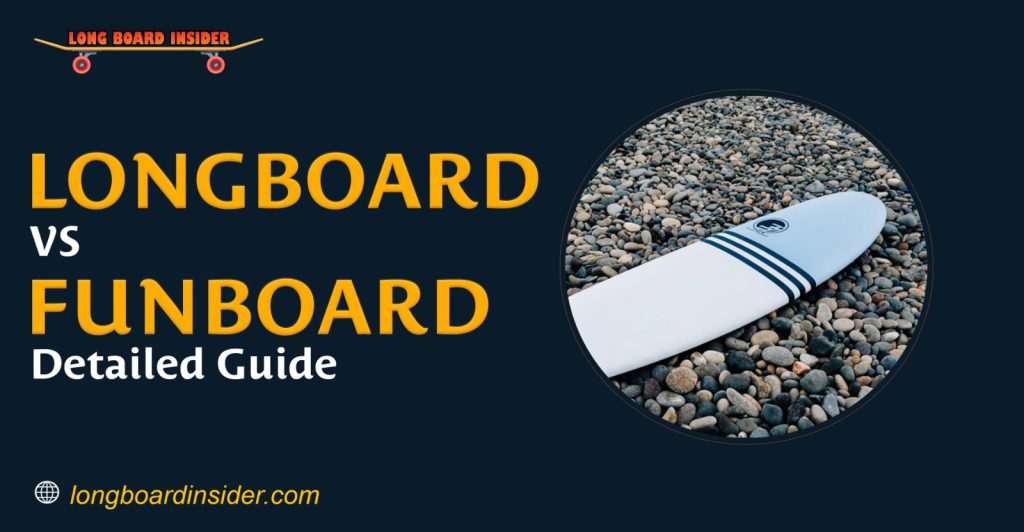Longboards and fun boards are two types of surfboard that offer different features and benefits. Both boards can be used to ride waves, but they have distinct shapes, sizes, and materials that make them suited for other purposes. To pick the right board for your needs, it’s essential to understand the differences between a longboard and a fun board.
Learning about longboard or fun board, which one is the best for catching more giant waves, cruising along flat water sections, performing traditional maneuvers like hanging ten or cross-stepping, making long rides along the shore, and providing a smooth ride in smaller waves.
Funboards are generally shorter than longboards, ranging from 5-7 feet long. They feature a wider nose shape and may have two fins or an integral thruster setup that helps with steering.
Differences Between Longboard and Funboard

Length
Longboards are usually longer than fun boards, ranging from 8-10 feet. Funboards are generally shorter, ranging from 5-7 feet in length.
Nose Shape
Longboards typically have a rounded or pointed nose shape, while fun boards have a wider nose shape.
Fin design
Longboards usually have one fin, while fun boards may feature two fins or an integral thruster setup for increased manoeuvrability and control.
Stability
Due to their large surface area, long boards offer more stability than other boards, while fun boards provide less stability due to the shorter length and width of the board.
Manoeuvrability
Funboards offer more maneuverability than longboards, allowing riders to perform sharp turns and aerial tricks.
Wave size
Longboards are best for catching more giant waves, while fun boards are ideal for riding small to medium-sized waves.
Performance
Longboards offer a smoother ride in smaller waves and can perform traditional manoeuvres like hanging ten or cross-stepping. At the same time, fun boards are better suited for performing sharp turns, aerial tricks, and other manoeuvres like cutbacks, floaters, laybacks, snaps, and re-entries.
Speed
Longboards have the potential to go faster than fun boards due to their larger surface area, but speed is also dependent on wave conditions.
Material
Both boards may be made from various materials, such as foam or fiberglass.
Cost
Longboards typically cost more than fun boards due to the additional material and craftsmanship required for larger boards.

Understanding the differences between longboard and fun boards lets you decide which type best suits your needs and abilities. Whether you’re looking to ride more giant waves with a smoother, more stable ride or want to perform tricks and maneuvers in smaller waves, there’s a surfboard that will work perfectly for you.
Advantages and Disadvantages of Fun Board
Advantages
Funboards are more accessible to maneuver than longboards, offering increased agility and control for experienced riders. They’re also smaller and lighter, making them more portable and easier to store when not in use. Funboards are great for riders who want to catch smaller waves or practice manoeuvres like cutbacks, floaters, laybacks, snaps, and re-entries.
Disadvantages
Since fun boards have a wider nose shape, they offer less stability than longboards when riding more giant waves. Additionally, their manoeuvrability makes them well-suited for advanced techniques but can be more challenging for beginner riders to learn. Funboards wear out faster than longboards due to the smaller surface area.
Advantages and Disadvantages of Longboard
Advantages
Longboards offer more stability than fun boards, making them ideal for riding giant waves or cruising along flat water sections. They’re also great for performing traditional maneuvers like hanging ten or cross-stepping. Longboards have a longer life span than fun boards since they feature a larger surface area.
Disadvantages
Longboards’ increased size and weight make them less portable and more complicated to store when not in use. They’re not as maneuverable as fun boards, so they may be more challenging for beginner riders to learn. Additionally, their larger size makes them better suited for more giant waves so that they will be less fun in smaller and weaker conditions.
FAQs
Which type of board should I get if I’m a beginner?
Starting with a fun board is best if you’re a beginner, as it is easier to maneuver and has increased agility and control. This will make it much easier for you to learn the basics of surfing.
What types of manoeuvres can be performed on longboards vs fun boards?
Longboards are great for performing traditional manoeuvres like hanging ten or cross-stepping. At the same time, fun boards are better suited for performing sharp turns, aerial tricks and other manoeuvres like cutbacks, floaters, laybacks, snaps and re-entries.
How does size affect performance?
Smaller boards are more agile and manoeuvrable than larger boards, so they are better suited for smaller waves and tricks. Larger panels offer increased stability and can go faster in more giant waves.
When should you switch to a fun board?
Switching to a fun board is ideal if you feel comfortable on your longboard and want to progress from performing traditional manoeuvres to more advanced tricks. Its increased manoeuvrability and agility can help you take the next step in your surfing journey.
Conclusion
When deciding which board is best for you, consider what types of waves you’ll be riding most often. Longboards offer more stability for giant waves, while fun boards provide better maneuverability for smaller waves. The board size should also be considered, as larger boards are more challenging to transport and store. Choose a board that best suits your surfing needs and abilities.
Safety should always be a top priority regardless of the type of board you choose. Always wear appropriate safety gear when on the water and check with local regulations before heading out. With the right board and safety precautions, you’ll be super-duper-ready to enjoy a safe and fun surf day.

